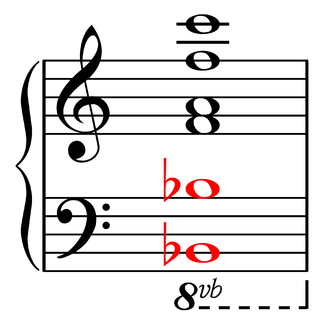In music theory, a tetrachord is a series of four notes separated by three intervals. In traditional music theory, a tetrachord always spanned the interval of a perfect fourth, a 4:3 frequency proportion —but in modern use it means any four-note segment of a scale or tone row, not necessarily related to a particular tuning system.
In music, the subtonic is the degree of a musical scale which is a whole step below the tonic note. In a major key, it is a lowered, or flattened, seventh scale degree. It appears as the seventh scale degree in the natural minor and descending melodic minor scales but not in the major scale. In major keys, the subtonic sometimes appears in borrowed chords. In the movable do solfège system, the subtonic note is sung as te.
In music, a hexachord is a six-note series, as exhibited in a scale or tone row. The term was adopted in this sense during the Middle Ages and adapted in the 20th century in Milton Babbitt's serial theory. The word is taken from the Greek: ἑξάχορδος, compounded from ἕξ and χορδή, and was also the term used in music theory up to the 18th century for the interval of a sixth.
Dorian mode or Doric mode can refer to three very different but interrelated subjects: one of the Ancient Greek harmoniai ; one of the medieval musical modes; or—most commonly—one of the modern modal diatonic scales, corresponding to the piano keyboard's white notes from D to D, or any transposition of itself.
Mixolydian mode may refer to one of three things: the name applied to one of the ancient Greek harmoniai or tonoi, based on a particular octave species or scale; one of the medieval church modes; or a modern musical mode or diatonic scale, related to the medieval mode.
The Aeolian mode is a musical mode or, in modern usage, a diatonic scale also called the natural minor scale. On the white piano keys, it is the scale that starts with A. Its ascending interval form consists of a key note, whole step, half step, whole step, whole step, half step, whole step, whole step. That means that, in A aeolian, you would play A, move up a whole step to B, move up a half step to C, then up a whole step to D, a whole step to E, a half step to F, a whole step to G, and a final whole step to a high A.
The Phrygian mode can refer to three different musical modes: the ancient Greek tonos or harmonia, sometimes called Phrygian, formed on a particular set of octave species or scales; the medieval Phrygian mode, and the modern conception of the Phrygian mode as a diatonic scale, based on the latter.

Pandiatonicism is a musical technique of using the diatonic scale without the limitations of functional tonality. Music using this technique is pandiatonic.

In music, a subject is the material, usually a recognizable melody, upon which part or all of a composition is based. In forms other than the fugue, this may be known as the theme.
In the musical system of ancient Greece, genus is a term used to describe certain classes of intonations of the two movable notes within a tetrachord. The tetrachordal system was inherited by the Latin medieval theory of scales and by the modal theory of Byzantine music; it may have been one source of the later theory of the jins of Arabic music. In addition, Aristoxenus calls some patterns of rhythm "genera".
The Locrian mode is the seventh mode of the major scale. It is either a musical mode or simply a diatonic scale. On the piano, it is the scale that starts with B and only uses the white keys from there. Its ascending form consists of the key note, then: half step, whole step, whole step, half step, whole step, whole step, whole step.

A consort of instruments was a phrase used in England during the 16th and 17th centuries to indicate an instrumental ensemble. These could consist of the same or a variety of instruments. Consort music enjoyed considerable popularity at court and in the households of the wealthy in the Elizabethan era, and many pieces were written for consorts by the major composers of the period. In the Baroque era, consort music was absorbed into chamber music.
The Hypolydian mode, literally meaning "below Lydian", is the common name for the sixth of the eight church modes of medieval music theory. The name is taken from Ptolemy of Alexandria's term for one of his seven tonoi, or transposition keys. This mode is the plagal counterpart of the authentic fifth mode.

The Hypodorian mode, a musical term literally meaning 'below Dorian', derives its name from a tonos or octave species of ancient Greece which, in its diatonic genus, is built from a tetrachord consisting of a semitone followed by two whole tones. The rising scale for the octave is a single tone followed by two conjoint tetrachords of this type. This is roughly the same as playing all the white notes of a piano from A to A: A | B C D E | (E) F G A. Although this scale in medieval theory was employed in Dorian and Hypodorian, from the mid-sixteenth century and in modern music theory they came to be known as the Aeolian and Hypoaeolian modes.

The archicembalo was a musical instrument described by Nicola Vicentino in 1555. This was a harpsichord built with many extra keys and strings, enabling experimentation in microtonality and just intonation.

A common chord, in the theory of harmony, is a chord that is diatonic to more than one key or, in other words, is common to two keys. A "common chord" may also be defined simply as a triadic chord, as one of the most commonly used chords in a key (I–IV–V–vi–ii–iii), more narrowly as a triad in which the fifth is perfect, in which sense it is alternatively referred to as a "perfect chord" or, more narrowly still, as a major triad only.
Ionian mode is a musical mode or, in modern usage, a diatonic scale also called the major scale.

A tetrad is a set of four notes in music theory. When these four notes form a tertian chord they are more specifically called a seventh chord, after the diatonic interval from the root of the chord to its fourth note. Four-note chords are often formed of intervals other than thirds in 20th- and 21st-century music, however, where they are more generally referred to as tetrads. Allen Forte in his The Structure of Atonal Music never uses the term "tetrad", but occasionally employs the word tetrachord to mean any collection of four pitch classes. In 20th-century music theory, such sets of four pitch classes are usually called "tetrachords".

Clamor Heinrich Abel was a German composer, violone player and organist.
The musical system of ancient Greece evolved over a period of more than 500 years from simple scales of tetrachords, or divisions of the perfect fourth, into several complex systems encompassing tetrachords and octaves, as well as octave scales divided into seven to thirteen intervals.








